Gold Panning In Vermont
We were invited to go gold panning when we joined a treasure hunting club. In spite of a lack of knowledge in this area, we were eager to go and try to find some of this yellow precious metal.
Both of us were curious as to how it is done, and the techniques that are used to find gold. I personally envisioned a goldpan as a sieve, with the holes on the bottom, that would catch the gold nuggets. : -)
Our First Gold Panning Trip
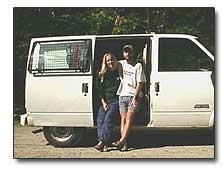 Our trip was set up on a weekend, with all the club members arriving early Saturday morning at a elusive location in Vermont. We decided to leave Friday night after work, so we could get there on time. Arriving in Vermont late at night, we totally got lost in the dark, but since we knew we were in the general area of the gold mine, we decided to pull over to the side of the road and get some sleep.
Our trip was set up on a weekend, with all the club members arriving early Saturday morning at a elusive location in Vermont. We decided to leave Friday night after work, so we could get there on time. Arriving in Vermont late at night, we totally got lost in the dark, but since we knew we were in the general area of the gold mine, we decided to pull over to the side of the road and get some sleep.
We awakened early in the morning by the sound of a bubbling brook, and proceeded to look for the location of the mine. We kept driving up and down the highway, and finally decided to ask a local business. Surprisingly, where we were suppose to turn, was right across the street. It turned out to be a dirt road with no signs. No wonder we couldn't find it. We followed the winding dirt road, which snaked through the woods, following a stream. It was still early, so we decided just to wait for the others before we got lost again.
We ate a quick breakfast and I jumped in the brook to see if I could locate some gold. Being a total novice like I said before, I found several rocks that sparkled in the sunlight. I proudly presented them to Carol and we kept them for later investigation. We had visions of striking it rich today, and couldn't wait for the real hunt.
The Real Hunt for Gold
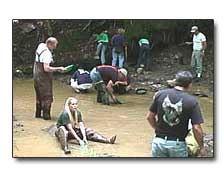 Finally the club members started to arrive, and we followed one of them to the location of the mine. We set up our tent in a small field right by the brook. After everyone was there and settled, we were taken downstream through the woods to the location of the old abandoned gold mine.
Finally the club members started to arrive, and we followed one of them to the location of the mine. We set up our tent in a small field right by the brook. After everyone was there and settled, we were taken downstream through the woods to the location of the old abandoned gold mine.
We were surprised to see that it was a huge mud pool adjacent to a creek. The current landowner and president of the Goldminers of New England explained to us that this mine was abandoned when they discovered gold in California, but there was still gold to be found right here under our feet.
We were all given some goldpans, which looked like a large plate with ridges on the inside rims. Rather than the sieve I had envisioned in my mind, I was puzzled, as how this pan could catch the gold. After some brief instructions, and a few tries, I had yet to find that elusive gold.
Other experienced members, that had done this before, took the time to describe the process to us.
How To Goldpan
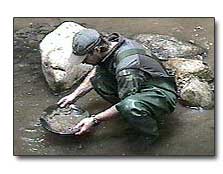 My thinking that the gold is embedded inside the rocks as some shiny flakes, was totally wrong. The gold is actually real small particles that have settled in the bank, in the clay, and bedrock. Some pieces being larger than others.
My thinking that the gold is embedded inside the rocks as some shiny flakes, was totally wrong. The gold is actually real small particles that have settled in the bank, in the clay, and bedrock. Some pieces being larger than others.
Now, knowing that the gold is at the bottom of your pan, you can safely remove all the larger rocks and gravel out of the top of your pan. But be sure to dissolve all the lumps of clay and dirt in your pan before removing the rocks, because that is where the gold is most likely to be. After that, you should have mostly sand and smaller pebbles left in your pan.
Tilt your goldpan at approximately forty five degrees with the ridges pointing down toward the water. Dunk it in the water several times to remove more of the smaller sand and pebbles. The gold will be caught in the ridges of the pan. Keep washing it until you start seeing black sand, which is an iron oxide. This is the second heaviest material after gold in your pan. Now leave a little bit of water in the pan and swirl it around, looking for the yellow specks.
Gold Strike
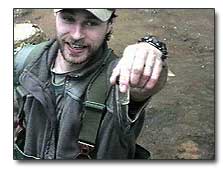 After seeing the success of others, and a little trial and error, I was very excited to find my first gold speck. :- ) It looked kind of lost in that big vile that a friend let me borrow. But I was still excited, because this was my first natural gold find. The entire day was spent in that puddle panning for gold. Many of the club members had never done this before, and everyone seemed to have fun finding some gold.
After seeing the success of others, and a little trial and error, I was very excited to find my first gold speck. :- ) It looked kind of lost in that big vile that a friend let me borrow. But I was still excited, because this was my first natural gold find. The entire day was spent in that puddle panning for gold. Many of the club members had never done this before, and everyone seemed to have fun finding some gold.
Did we have fun? Yes, but it was hard work and you had to be real careful not to let those flakes and clinkers as they call them, slip by. They're called clinkers because smaller gold nuggets make a clink sound when you shake the little glass vile.
The Next Day
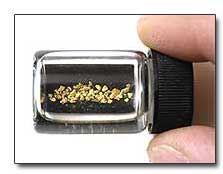 The next morning we made a campfire, ate some breakfast and had a metal detecting hunt in the field. This is how we won the Garrett
Pocket Probe on the Metal Detecting Accessories page. Everyone couldn't wait to get back in the mud pool with their pans to find more gold.
The next morning we made a campfire, ate some breakfast and had a metal detecting hunt in the field. This is how we won the Garrett
Pocket Probe on the Metal Detecting Accessories page. Everyone couldn't wait to get back in the mud pool with their pans to find more gold.
We enjoyed it so much we decided to join the gold mining club. We traveled across New England, and even went to Canada to pan for the elusive gold metal.
Even though it was so much fun, we find more gold with our metal detectors on local beaches. But whether natural or in the form of rings and jewelry, it sure did help us to understand how gold behaves when it's dropped into the water.